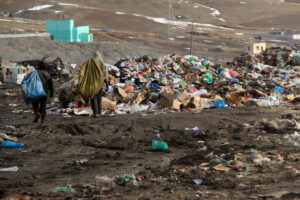Globally, merely a minor fraction of discarded plastic is being recycled or incinerated in waste-to-energy facilities. Enormous quantities of non-biodegradable plastic that takes more than 1,000 years to decompose is accumulating in landfills and potentially toxic substances are leaching into our soil, air, and water resources. In recent times, research and media reports are focusing on unknown and neglected aspect of plastic contamination posing severe threat to the plants and animals (including humans) based on terrestrial habitat.
 .
.
(picture coutesy: soil pollution – Bing images)
Let us understand some of the essential facts about effect of plastics on soil and land in order to preserve and secure our environment. Important details are as follows:
• Many researchers are warning regarding the impact of microplastics in soils, sediments, and freshwater. This nano-particulate plastic matter resides in soil for thousands of years and causes long-term negative effect on our ecosystems.
• Approximately, 1/3rd of all plastic waste gets collected into the fertile soil and enter the food chain. The plastic matter disintegrates into fine particles named microplastics (less than 5 mm) and further break down into nanoparticles (less than 0.1 micrometer).
• Sewage and sludge are major factors that distribute microplastics from landfills too far and distant agricultural fields as well as freshwater resources used for irrigation and drinking purposes. Sludge contains 80-90 per cent microplastics and is often applied to fields as fertilizer, so, the edible plants and crops are harboring these hazardous toxins and chemical pollutants.
• The surfaces of tiny plastic fragments carry disease-causing organisms and act as vectors for diseases and infections. Microplastics interact and affect the biological processes and functions of beneficial soil fauna which degrades the fertility of soil.
• Chlorinated plastic releases harmful chemicals into the surrounding soil and seeps into groundwater and drinking water sources. Ultimately, health and productivity of several important species of plants and animals is deteriorated leading to ruination of ecosystems.
• The terrestrial microplastic pollution is a greater threat compared to the marine microplastic pollution. Research estimates propose about 4 to 23 times higher devastating impact on land ecosystems than that on water ecosystems.
• Study reports from all over the world conclude that soil resources are being damaged at an alarming rate owing to the presence of fragments of plastic that trigger many adverse effects on health and safety of our future generations.
How to prevent the disastrous effect of plastic microparticles
Numerous countries and organizations around the world have introduced legislation to ban the manufacture of several synthetic and plastic products containing plastic minuscule fibers, microbeads, and nanoparticles. We must uphold and support these laws by introducing more sustainable and dependable material sources such as cotton, jute, and natural fibres. We must avoid purchase of plastic, acrylic, nylon, spandex, and polyester products to reduce their production for commercial purposes. We must spread awareness to combine science and policy to understand the status, causes, impacts, and solutions to soil pollution. The outcome paves the path to implement and coordinate multiple set of actions to stop plastic pollution of soil.
